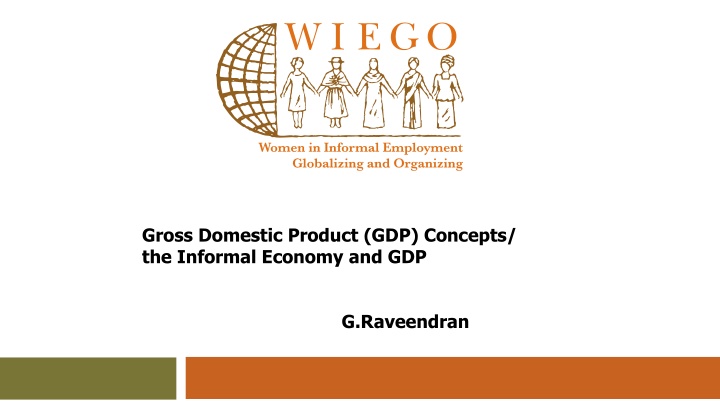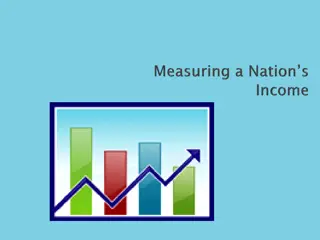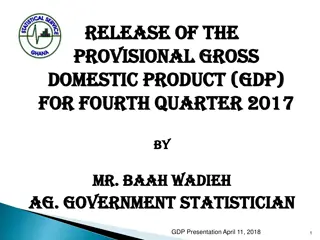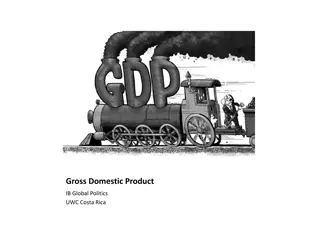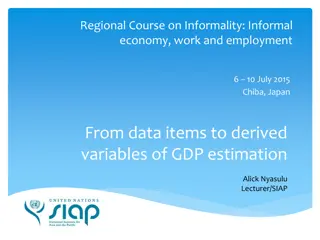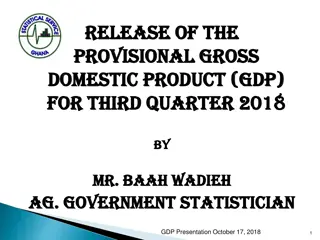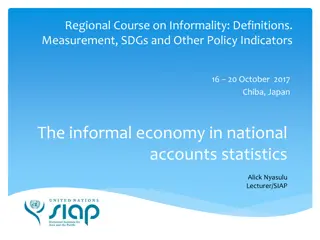GDP Concepts and Measurement Approaches
Gross Domestic Product (GDP) is a key economic indicator that measures the total output of goods and services within a country or region. This includes production by corporations, government bodies, households, and non-profit institutions. The informal economy, factors of production, and measurement principles such as the production, income, and expenditure approaches are essential components when analyzing GDP. Various exercises and illustrations demonstrate the inter-industry consumption of production and value addition. The frontiers of production explore both market and non-market outputs, encompassing a wide range of economic activities. Factor payments for land, capital, labor, and entrepreneurship play a crucial role in the economic framework, highlighting who contributes to production. By utilizing different measurement approaches, GDP can be assessed through market sales, changes in inventories, and imputed values for non-market outputs like housing services. These concepts and principles offer valuable insights into the complexities of GDP calculation.
Download Presentation

Please find below an Image/Link to download the presentation.
The content on the website is provided AS IS for your information and personal use only. It may not be sold, licensed, or shared on other websites without obtaining consent from the author.If you encounter any issues during the download, it is possible that the publisher has removed the file from their server.
You are allowed to download the files provided on this website for personal or commercial use, subject to the condition that they are used lawfully. All files are the property of their respective owners.
The content on the website is provided AS IS for your information and personal use only. It may not be sold, licensed, or shared on other websites without obtaining consent from the author.
E N D
Presentation Transcript
Gross Domestic Product (GDP) Concepts/ the Informal Economy and GDP G.Raveendran
Gross Domestic Product (GDP) The output (production) by resident Financial and Non-financial Corporations Government Bodies Non-profit Institutions Households Produced within the economic boundary of the country/region Measured without double counting
GDP EXERCISE OUT PUT AND INTER-INDUSTRY CONSUMPTION OF PRODUCTION (000000 YEN) INDUSTRY A B C TOTAL A B C 50 100 150 150 50 200 100 250 150 500 700 800
GDP EXERCISE-1 OUT PUT AND INTER-INDUSTRY CONSUMPTION OF PRODUCTION (000000 YEN) INDUSTRY A B A 50 150 B 100 50 C 150 200 VALUE ADDITION C 100 250 150 300 TOTAL 500 700 800 200 300 TOTAL 500 700 800 2000
FACTORS OF PRODUCTION- WHO PRODUCES Land Capital Labour Entrepreneur
FACTOR PAYMENTS Land - Rent Capital - Interest Labour - Wages Entrepreneur - Profit
Measurement Approaches Production Approach Income Approach Expenditure Approach
Frontiers of Production (GDP) Market Output (Production of goods & services intended to be sold) Non-market output of government and non- profit institution Production of goods by households for own consumption Own account production of capital goods by businesses Housing services (imputed rents) of home owner-occupiers, not including other services produced by households for their own account
Measurement Principles Market output (sales) plus changes in inventories of finished products and work in progress. Measured at basic prices- per unit revenue received by the producer, excluding taxes on products but including subsidies on products. Non-market output of general government and non-profit institutions is measured by the sum of its costs, including compensation of employees, consumption of fixed capital. Housing services provided by home owner occupiers are imputed as being equal to the rents they would have paid for comparable housing
INSTITUTIONAL SECTORS OF PRODUCTION Non-Financial Corporations Financial Corporations Government Units including Social Security Funds Non-Profit Institutions Serving Households (NPISHs) Households
Institutional Units in National Accounts (contd) Non-financial corporations are institutional units primarily engaged in the production of market goods and non-financial services. Financial corporations are institutional units primarily engaged in financial intermediation or in auxiliary financial activities. General governments are institutional units which in addition to fulfilling their political responsibilities and role of economic regulation, produce principally non-market services for individual or collective consumption and re-distribute income & wealth.
Institutional Units in National Accounts (contd) Households include all physical persons in the economy, with the institutional unit consisting of one individual or a group of individuals (Pure households). It also includes unincorporated enterprises owned by the household (Household sector). The Principal functions of the households are the supply of labour, financial consumption and as entrepreneurs production of market goods and services. Non-profit institutions serving households (NPISHs) are entities which are principally engaged in the production of non-market services to households and whose main resources are voluntary contributions by households.
INFORMAL SECTOR Essentially a part of the household sector Includes both financial and non-financial production units Detailed accounts may not be available to separate the accounts of the enterprise from that of the household List frames of enterprises may not be easily available due to non-registration May not be employing paid workers (own account enterprises) or may be employing very few workers (establishments). Usually not covered in the regular statistical reporting system.
ESTIMATING GDP CONTRIBUTION OF INFORMAL SECTOR Estimate Labour Input from Labour Force Surveys by Industry Group Estimate Average Value Added Per Worker (VAPW) from Informal Sector Surveys or Mixed Surveys for each of the Industry Group Estimate Gross Value Added (GVA) by Multiplying the Estimated Labour Input with the Corresponding VAPN
THANK YOU WIEGO
